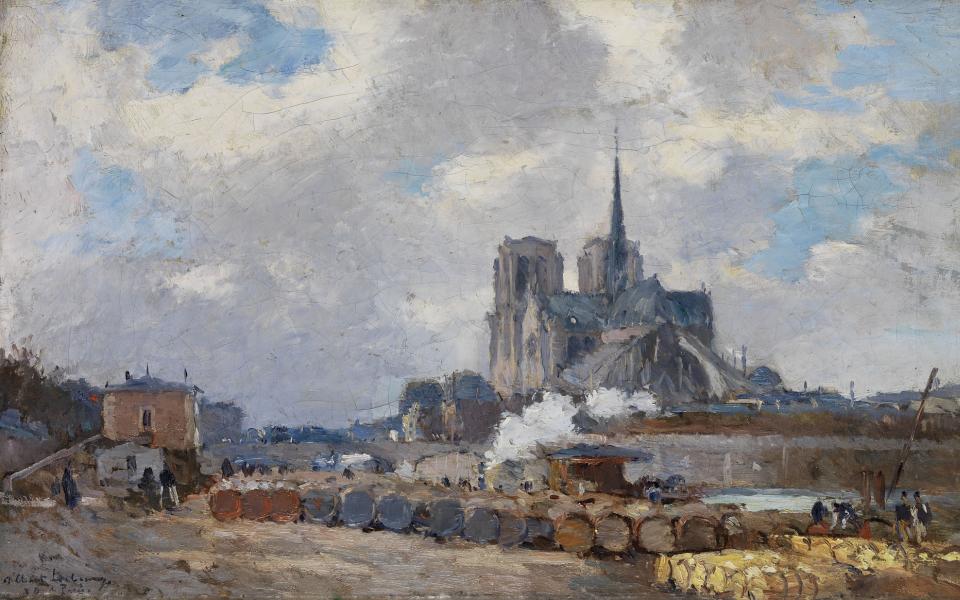
Albert Lebourg, Notre Dame de Paris, vue du Quai de la Tournelle, 1928
I write this article two days after the fire in the Cathedral of Notre Dame in Paris, and exactly one hundred years to the day of the San Francisco Earthquake and Fire of 1906 when Grace Cathedral burned to the ground.
Paris
My first reaction when I saw the flames was that this was unthinkable. For so many centuries, for so much cultural and political history and for my little life, the Cathedral of Notre Dame was permanent, a given. Always was and always will be. But there before our eyes, in real time, all over the whole world, the Cathedral was burning.
The sight of a cathedral carves out a large space inside us. Actually, most of a cathedral is space. Yes, the pillars and towers are impressive. The ceiling knocks our heads back. But what mostly touches the soul in a cathedral is what is not seen. The largest part of a cathedral has nothing in it. This is sacred space, strangely quiet and calling out the strangely quiet, inward part of our lives. Such a cathedral is not essentially something to be admired. Its naked holiness in outward space beckons us to reveal the holy hiddenness of our naked inward space.
“Deep calls to deep.”
A burning cathedral is something else. Here was France caught up in fracturing divisions. “Yellow Vests” vs. the government. The Muslim suburbs vs. the traditional French. The rise of nationalism vs. the EU and global advocates. But for a time, while the Cathedral burned, there was an undivided nation. Sometimes, it takes a burning cathedral to unify a diffuse people.
Out of the corner of my ear, I thought that I heard that the building and grounds of the Notre Dame Cathedral are owned by the government, but the Church runs the operation. If this is so, then it is exactly as it should be. A parish church is about a specific religious denomination, but a cathedral, a House of Prayer for All People, has a far wider vocation. It also has a civic responsibility; therefore, all manner of folks are welcomed and invited to be at home.
San Francisco
The word “cathedral” comes from the Latin word “cathedra” which means “the seat.” In this case, a cathedral is the seat of a bishop. For 27 years I sat in that seat, and I must say... I was so privileged to be part of the music, the art, the civic engagement, the challenges of a place of such profound meaning
One early morning before a very large public funeral, I knew that hosts of people would flood through the large doors, people who had no idea of what a cathedral was. So I woke up early and hurriedly wrote about three aspects:
- “A cathedral is a place of Immunity: Immunity for the ravages of religion and misuse of Divine revelation…. How to avail oneself of the soul-inspiring testimony of religion through the ages and, at the same time, receive some guarantee of immunity from the power perversions that so often follow in the wake of religious striving?”
- “ A cathedral is a place of Anonymity…. A cathedral has a high ceiling and long aisles to allow the contained soul an opportunity to venture forth in multiple directions without the encumbrances of forced community.”
- “A cathedral is a place of Unity: we believe that God is the Alpha…and the Omega, so at the beginning and at the end, all aspects of life are in unity. Meanwhile we are a people who hold unto the extravagant hope of unity in this world, now.”
San Francisco is a two-cathedral city: a Roman Catholic cathedral and an Episcopal cathedral. In the 20th century, both of our cathedrals went up in flames. And... both were rebuilt, larger, stronger and more aesthetically inspiring. “Resurrection” is the appropriate word. And more appropriate still because of this week leading up to Easter.
“Behold, I make all things new.”